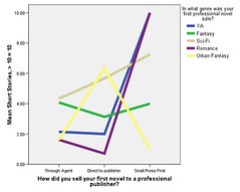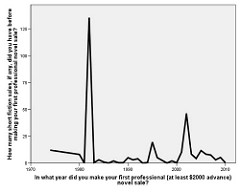This is part four of my further analysis of Jim C. Hines’ great survey of first novel sales. You might want to see parts one, two, and three; there is one final portion tomorrow that will address “networking” and how it affected novel sales in this sample. Click images to embiggen.
Short Story Sales, Method of Sale, and Year
Executive Summary: There’s no real relationship between number of short stories before the first novel sold, not even when separated out by genre and time. The only real relationship is that (with the exception of urban fantasy) authors who sold more short stories tended to sell to small presses or to agents. It is likely (though I cannot prove causation) that this is because those who have sold more short stories have been writing longer and are more exposed to both agents and are more familiar with small presses.
There’s only three graphs today, and no tables. Largely, this is because the tables for this output does not add anything to the visual elements, and is a hell of a lot more confusing. (That and I remembered how to make SPSS chart multiple things at once.) The first relationship I would like to look at is the year of first novel sale by the (average) number of short stories sold by authors who sold their first novel in that year.
This is obviously not normalized data; there were a few individuals that strongly skewed the averages for a few years. (Remember that averages are more susceptible to being skewed by outliers than medians or means.) Regardless, there’s no real evident trend – and the stats behind this relationship have completely nonsignificant chi-squares, let alone any measures of association.
So what if we break it down by genre? (Again, these are averages per year of first novel sold.)
As with the data in part three, I concentrated on YA, science fiction, fantasy, romance, and urban fantasy. The outliers are very, very clear here, though we do see that more people are selling more short stories before their first novel in the last few years. I discussed this slightly in part two; half of the respondents had sold no short stories prior to their first novel sale, but more people had sold more short stories since the 1980’s. As someone who enjoys short stories, I think this is a great thing… but it seems to bear more relationship to authorial habits (and advice to authors) than having any predictive value. The statistics were once again completely nonsignificant.
That leaves us the only thing that seems to have any relationship at all (though I caution that the statistics are still nonsignificant):
The average number of short stories sold by how the first novel was sold seems to have some kind of relationship in all genres except for urban fantasy. People who sold their first pro novels through agents or small presses had sold more short stories first. I conjecture that this is a “soft” relationship, and that the exception of urban fantasy proves the rule. [1]
The strong exception of urban fantasy here would seem to play merry hell with my associations here, but I’m not sure about that. The basic trend seems to be that people who have sold more short stories are more familiar with publishing, and so use agents and small presses more. (This also fits with my own experience; I was largely unaware of small presses until I started writing more.) Urban fantasy is different, but I suspect this has to do with the “hotness” of the genre in the last decade or so. The perceived demand for urban fantasy would lead agents (in particular) to snag novelists. If you look back at the final graph for part three, that seems to be the case with the vastly disproportionate number of agented sales.
Okay, folks, part five – networking – is tomorrow to wrap us up.
[1] Yes, I know what that phrase actually means.
